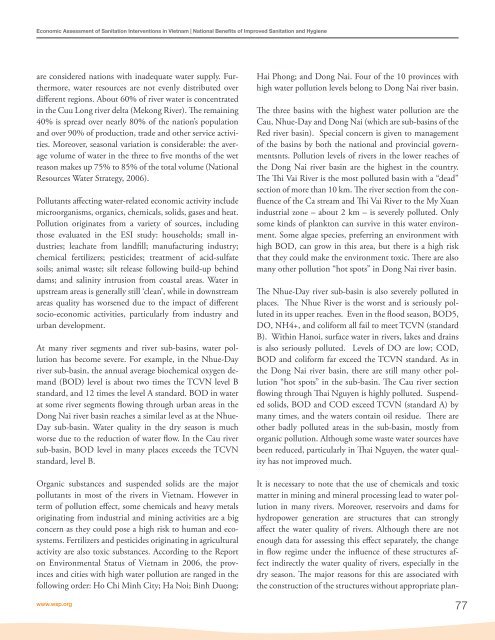Economic Assessment of Sanitation Interventions in Vietnam - WSP
Economic Assessment of Sanitation Interventions in Vietnam - WSP
Economic Assessment of Sanitation Interventions in Vietnam - WSP
Create successful ePaper yourself
Turn your PDF publications into a flip-book with our unique Google optimized e-Paper software.
<strong>Economic</strong> <strong>Assessment</strong> <strong>of</strong> <strong>Sanitation</strong> <strong>Interventions</strong> <strong>in</strong> <strong>Vietnam</strong> | National Benefits <strong>of</strong> Improved <strong>Sanitation</strong> and Hygieneare considered nations with <strong>in</strong>adequate water supply. Furthermore,water resources are not evenly distributed overdifferent regions. About 60% <strong>of</strong> river water is concentrated<strong>in</strong> the Cuu Long river delta (Mekong River). The rema<strong>in</strong><strong>in</strong>g40% is spread over nearly 80% <strong>of</strong> the nation’s populationand over 90% <strong>of</strong> production, trade and other service activities.Moreover, seasonal variation is considerable: the averagevolume <strong>of</strong> water <strong>in</strong> the three to five months <strong>of</strong> the wetreason makes up 75% to 85% <strong>of</strong> the total volume (NationalResources Water Strategy, 2006).Pollutants affect<strong>in</strong>g water-related economic activity <strong>in</strong>cludemicroorganisms, organics, chemicals, solids, gases and heat.Pollution orig<strong>in</strong>ates from a variety <strong>of</strong> sources, <strong>in</strong>clud<strong>in</strong>gthose evaluated <strong>in</strong> the ESI study: households; small <strong>in</strong>dustries;leachate from landfill; manufactur<strong>in</strong>g <strong>in</strong>dustry;chemical fertilizers; pesticides; treatment <strong>of</strong> acid-sulfatesoils; animal waste; silt release follow<strong>in</strong>g build-up beh<strong>in</strong>ddams; and sal<strong>in</strong>ity <strong>in</strong>trusion from coastal areas. Water <strong>in</strong>upstream areas is generally still ‘clean’, while <strong>in</strong> downstreamareas quality has worsened due to the impact <strong>of</strong> differentsocio-economic activities, particularly from <strong>in</strong>dustry andurban development.At many river segments and river sub-bas<strong>in</strong>s, water pollutionhas become severe. For example, <strong>in</strong> the Nhue-Dayriver sub-bas<strong>in</strong>, the annual average biochemical oxygen demand(BOD) level is about two times the TCVN level Bstandard, and 12 times the level A standard. BOD <strong>in</strong> waterat some river segments flow<strong>in</strong>g through urban areas <strong>in</strong> theDong Nai river bas<strong>in</strong> reaches a similar level as at the Nhue-Day sub-bas<strong>in</strong>. Water quality <strong>in</strong> the dry season is muchworse due to the reduction <strong>of</strong> water flow. In the Cau riversub-bas<strong>in</strong>, BOD level <strong>in</strong> many places exceeds the TCVNstandard, level B.Organic substances and suspended solids are the majorpollutants <strong>in</strong> most <strong>of</strong> the rivers <strong>in</strong> <strong>Vietnam</strong>. However <strong>in</strong>term <strong>of</strong> pollution effect, some chemicals and heavy metalsorig<strong>in</strong>at<strong>in</strong>g from <strong>in</strong>dustrial and m<strong>in</strong><strong>in</strong>g activities are a bigconcern as they could pose a high risk to human and ecosystems.Fertilizers and pesticides orig<strong>in</strong>at<strong>in</strong>g <strong>in</strong> agriculturalactivity are also toxic substances. Accord<strong>in</strong>g to the Reporton Environmental Status <strong>of</strong> <strong>Vietnam</strong> <strong>in</strong> 2006, the prov<strong>in</strong>cesand cities with high water pollution are ranged <strong>in</strong> thefollow<strong>in</strong>g order: Ho Chi M<strong>in</strong>h City; Ha Noi; B<strong>in</strong>h Duong;Hai Phong; and Dong Nai. Four <strong>of</strong> the 10 prov<strong>in</strong>ces withhigh water pollution levels belong to Dong Nai river bas<strong>in</strong>.The three bas<strong>in</strong>s with the highest water pollution are theCau, Nhue-Day and Dong Nai (which are sub-bas<strong>in</strong>s <strong>of</strong> theRed river bas<strong>in</strong>). Special concern is given to management<strong>of</strong> the bas<strong>in</strong>s by both the national and prov<strong>in</strong>cial governmentsnts.Pollution levels <strong>of</strong> rivers <strong>in</strong> the lower reaches <strong>of</strong>the Dong Nai river bas<strong>in</strong> are the highest <strong>in</strong> the country.The Thi Vai River is the most polluted bas<strong>in</strong> with a “dead”section <strong>of</strong> more than 10 km. The river section from the confluence<strong>of</strong> the Ca stream and Thi Vai River to the My Xuan<strong>in</strong>dustrial zone – about 2 km – is severely polluted. Onlysome k<strong>in</strong>ds <strong>of</strong> plankton can survive <strong>in</strong> this water environment.Some algae species, preferr<strong>in</strong>g an environment withhigh BOD, can grow <strong>in</strong> this area, but there is a high riskthat they could make the environment toxic. There are alsomany other pollution “hot spots” <strong>in</strong> Dong Nai river bas<strong>in</strong>.The Nhue-Day river sub-bas<strong>in</strong> is also severely polluted <strong>in</strong>places. The Nhue River is the worst and is seriously polluted<strong>in</strong> its upper reaches. Even <strong>in</strong> the flood season, BOD5,DO, NH4+, and coliform all fail to meet TCVN (standardB). With<strong>in</strong> Hanoi, surface water <strong>in</strong> rivers, lakes and dra<strong>in</strong>sis also seriously polluted. Levels <strong>of</strong> DO are low; COD,BOD and coliform far exceed the TCVN standard. As <strong>in</strong>the Dong Nai river bas<strong>in</strong>, there are still many other pollution“hot spots” <strong>in</strong> the sub-bas<strong>in</strong>. The Cau river sectionflow<strong>in</strong>g through Thai Nguyen is highly polluted. Suspendedsolids, BOD and COD exceed TCVN (standard A) bymany times, and the waters conta<strong>in</strong> oil residue. There areother badly polluted areas <strong>in</strong> the sub-bas<strong>in</strong>, mostly fromorganic pollution. Although some waste water sources havebeen reduced, particularly <strong>in</strong> Thai Nguyen, the water qualityhas not improved much.It is necessary to note that the use <strong>of</strong> chemicals and toxicmatter <strong>in</strong> m<strong>in</strong><strong>in</strong>g and m<strong>in</strong>eral process<strong>in</strong>g lead to water pollution<strong>in</strong> many rivers. Moreover, reservoirs and dams forhydropower generation are structures that can stronglyaffect the water quality <strong>of</strong> rivers. Although there are notenough data for assess<strong>in</strong>g this effect separately, the change<strong>in</strong> flow regime under the <strong>in</strong>fluence <strong>of</strong> these structures affect<strong>in</strong>directly the water quality <strong>of</strong> rivers, especially <strong>in</strong> thedry season. The major reasons for this are associated withthe construction <strong>of</strong> the structures without appropriate plan-www.wsp.org77
















